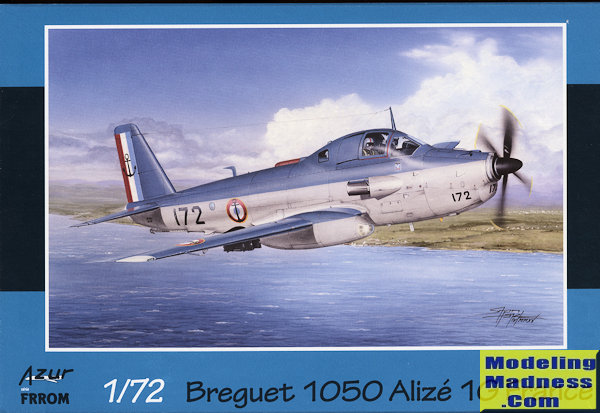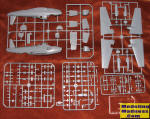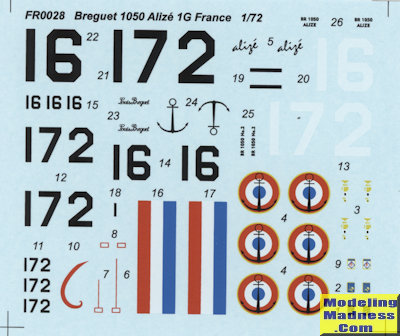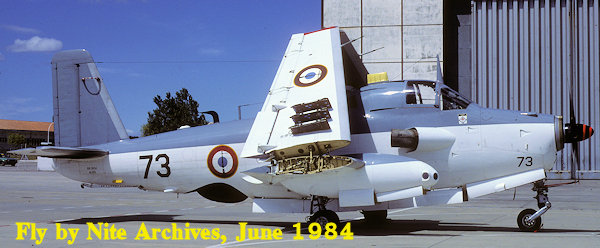
| KIT #: | FR0028 |
| PRICE: | $ |
| DECALS: | Three options |
| REVIEWER: | Scott Van Aken |
| NOTES: | New tool kit |

| HISTORY |
The Breguet Br.1050 Alizé (French: "Tradewind") was a French carrier-based anti-submarine warfare aircraft. It was developed in the 1950s, based loosely on the second prototype Breguet Vultur attack aircraft which had been modified into the Breguet Br.965 Épaulard anti-submarine warfare aircraft.
The Alizé was a low-wing monoplane of conventional configuration. It had a CSF radar system with a retractable antenna dome in its belly. The cockpit accommodated a crew of three, including pilot, radar operator, and sensor operator. The pilot was seated in front on the left, the navigator in front on the right, and the sensor operator sat sideways behind them. The landing gear was of tricycle configuration, with the main gear retracting backwards into nacelles in the wings. The main gear had dual wheels, and the front part of the nacelles accommodated sonobuoys. The Alizé had a yoke-style arresting hook.
The internal weapons bay could accommodate a homing torpedo or depth charges, and underwing stores pylons could carry bombs, depth charges, rockets, or missiles. Typical underwing stores included 68 mm (2.68 in) rocket pods or AS.12 wire-guided antiship missiles.
| THE KIT |
 The
folks at Azur/FRROM have a reputation for providing kits of aircraft that
have either not been modeled before, have only been done in other scales, or
have not been well modeled. Such is the case with the Breguet
Alizé. This is an aircraft that has been only
modeled once before in mainstream injected plastic, and that was by Heller. This
ancient kit was basically a prototype and it was typical of the late 1960's
in that it was lacking in detail and had some shape issues as well. Heller
did two boxings; one was in 1/100 and the other in 1/50. Heller released
these kits several times, including relatively recently in the last camo
scheme carried by the aircraft. Those with a penchant for masochism could
also build the much more modern F.M. 1/48 short run kit or the equally challenging Mach 2 1/72 version.
The
folks at Azur/FRROM have a reputation for providing kits of aircraft that
have either not been modeled before, have only been done in other scales, or
have not been well modeled. Such is the case with the Breguet
Alizé. This is an aircraft that has been only
modeled once before in mainstream injected plastic, and that was by Heller. This
ancient kit was basically a prototype and it was typical of the late 1960's
in that it was lacking in detail and had some shape issues as well. Heller
did two boxings; one was in 1/100 and the other in 1/50. Heller released
these kits several times, including relatively recently in the last camo
scheme carried by the aircraft. Those with a penchant for masochism could
also build the much more modern F.M. 1/48 short run kit or the equally challenging Mach 2 1/72 version.
Now we have a series of these planes produced by Azur/FRROM that pretty well supercedes all that has gone before. One thing most of us will like is that the kit is devoid of resin or photo etch and includes very nicely done clear bits. Looking at the sprues diagram you'll notice that there are quite a few parts not used. This is because all the kits will have pretty much the same sprues included, so one simply uses those that are appropriate for the boxing that you buy. This appears to be the initial production aircraft prior to any modifications done later in life.
The cockpit is nicely done with separate consoles, radio and ASW equipment along with different style seats for the various crew positions. Sidewall detail is provided as well and though not much will be visible in the black crew area, the detail is there. The small windows of the aircraft are inserted from inside prior to closing the fuselage halves. I should mention that there are, throughout the build, notes on opening up sections, again, depending on the aircraft that is kitted.
8 grams of nose weight will be needed and there is plenty of room to place this. The kit includes a separate radome bay and if doing the model in flight, this can be modeled in the lowered position.
The wings are upper and
lower halves on each side with a four piece gear bay. This bay is actually
nicely done and the rather complex landing gear can be installed after these
pods are glued onto the wing. As is normal for the early planes, the front
part of these pods are lights so use the clear bits provided. The kit has
single piece stabs and a separate rudder. Separate flap hinges are included
as well as the A frame arresting hook. Under the wings are six pylons. These
are to be painted black so you may want to wait until after the kit has been
painted to apply these. Note that on photos I have of the aircraft without
pylons, the pylon mounting holes are quite prominent so no need to fill
these if you model the airplane without all the pylons. A nice selection of
rockets, rocket pods and missiles is included. A one-piece cockpit canopy is
provided and the prop is actually two pieces and the spinner bits, something
a bit different.

The instruction booklet is superbly done with Gunze color information and detail reference diagrams throughout. All three options are in the blue-grey over white scheme. Note that this plane also was found with the undersides in a sort of sky green shade so you may wish to check photos if deviating from the kit offerings. The offerings are #172 from Flotille 4F in 1966-70, #1 from Squadron 10S in 1959-60, and #16 from Flotille 9F in 1966. This latter plane is the only one with a squadron badge and has the red spiral on the prop spinner. It also has yellow wing tips. Though from 1984, I've included a photo of an aircraft to use as a reference that you may find useful. Note that the photo shows an aircraft with mods not present on any of the kit planes. The decals are very nicely printed and offer the rudder stripes as well as the prop spira. When modeling #1, simply trim that number from the other options as needed.

| CONCLUSIONS |
This is really a nice kit of this interesting aircraft. The French have always marched to a different drummer and rarely purchase military aircraft from other nations, even though the unit cost would be higher by not doing so. Similar to the way Sweden operates. It results in some different types that are often missed by most model companies. This kit makes up for one omission and is such that even if one has not built a short run kit before, it should make for a nice introduction into the genre.
| REFERENCES |
https://en.wikipedia.org/wiki/Breguet_Aliz%C3%A9
March 2016
Copyright ModelingMadness.com
Thanks to www.frrom.com for the
preview kit. If you cannot find it locally, ask them to order it for you.
If you would like your product reviewed fairly and fairly quickly, please
contact the editor or see other details in the
Note to
Contributors.